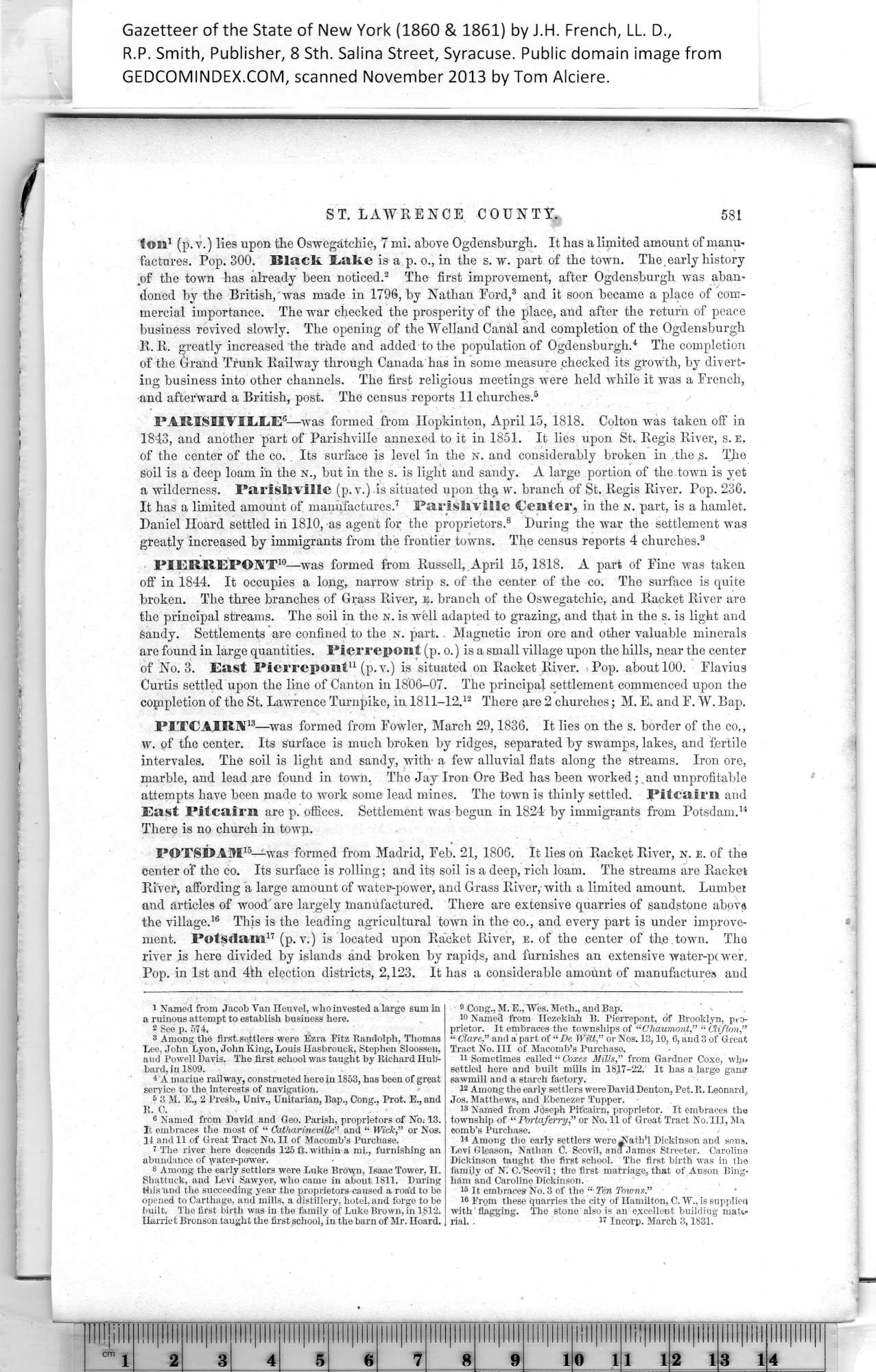|
ST. LAWRENCE COUNTY. 581
tom1 (p. v.) lies upon the Oswegatchie, 7 mi. above Ogdensburgh. It has a limited amount of manu-
factures. Pop. 300. Black Lake is a p. o., in the s. w. part of the town. The early history
.of the town has already been noticed.2 The first improvement, after Ogdensburgh was aban¬
doned by the British, was made in 1796, by Nathan Ford,3 and it soon became a place of com¬
mercial importance. The war checked the prosperity of the place, and after the return of peace
business revived slowly. The opening of the Welland Canal and completion of the Ogdensburgh
R. R. greatly increased the trade and added to the population of Ogdensburgh.4 The completion
of the Grand Trunk Railway through Canada has in some measure checked its growth, by divert¬
ing business into other channels. The first religious meetings were held while it was a French,
and afterward a British, post. The census reports 11 churches.5
PARISMVIEEE2—was formed from Hopkinton, April 15, 1818. Colton was taken off in
1843, and another part of Parishville annexed to it in 1851. It lies upon St. Regis River, s.e.
of the center of the co. Its surface is level in the n. and considerably broken in the s. The
soil is a deep loam in the x., but in the s. is light and sandy. A large portion of the town is yet
a wilderness. Parisln ville (p.v.) is situated upon the w. branch of St. Regis River. Pop. 236.
It has a limited amount of manufactures.3 Parlsli ville Center, in the n. part, is a hamlet.
Daniel Hoard settled in 1810, as agent for the proprietors.8 During the war the settlement was
greatly increased by immigrants from the frontier towns. The census reports 4 churches.9
PIERREPOJVT10—was formed from Russell, April 15,1818. A part of Fine was taken
off in 1844. It occupies a long, narrow strip s. of the center of the co. The surface is quite
broken. The three branches of Grass River, e. branch of the Oswegatchie, and Racket River are
the principal streams. The soil in the n. is well adapted to grazing, and that in the s. is light and
sandy. Settlements are confined to the n. part. Magnetic iron ore and other valuable minerals
are found in large quantities. Pierrepont (p. o.) is a small village upon the hills, near the center
of No. 3. East Pierrepont11 (p.v.) is situated on Racket River. >Pop. about 100. Flavius
Curtis settled upon the line of Canton in 1806-07. The principal settlement commenced upon the
completion of the St. Lawrence Turnpike, in 1811-12.12 There are 2 churches; M. E. and F. W. Bap.
PITCAIRJV4—was formed from Fowler, March 29,1836. It lies on the s. border of the co,,
w. pf the center. Its surface is much broken by ridges, separated by swamps, lakes, and fertile
intervales. The soil is light and sandy, with- a few alluvial flats along the streams. Iron ore,
marble, and lead are found in town. The Jay Iron Ore Bed has been worked; and unprofitable
attempts have been made to work some lead mines. The town is thinly settled. Pitcairn and
East Pitcairn are p. offices. Settlement was begun in 1824 by immigrants from Potsdam.14
There is no church in town.
POTSDAM15—was formed from Madrid, Feb. 21, 1806. It lies on Racket River, n. e. of the
center of the co. Its surface is rolling; and its soil is a deep, rich loam. The streams are Racket
River, affording a large amount of water-power, and Grass River, with a limited amount. Lumber
and articles of wood are largely manufactured. There are extensive quarries of sandstone abova
the village.16 This is the leading agricultural town in the co., and every part is under improve¬
ment. Potsdam17 (p. v.) is located upon Racket River, e. of the center of the town. Tho
river is here divided by islands and broken by rapids, and furnishes an extensive water-pcwer.
Pop. in 1st and 4th election districts, 2,123. It has a considerable amount of manufactures and
|
9 Cong., M.E., Wes. Meth., and Bap.
10 Named from Hezekiah B. Pierrepont, of Brooklyn, p.i>
prietor. It embraces the townships of “Chaumont,” “Clifton,”
“ Clare,” and a part of “ De Witt,” or Nos. 13,10, 6, and 3 of Great
Tract No. Ill of Macomb’s Purchase.
U Sometimes called “ Coxes Mills,” from Gardner Coxe, who
settled here and built mills in 1817-22. It has a large gang
sawmill and a starch factory.
12 Among the early settlers were David Denton, Pet. K. Leonard,
Jos. Matthews, and Ebenezer Tupper.
18 Named from Joseph Pitcairn, proprietor. It embraces the
township of “ Portaferry,” or No. 11 of Great Tract No. Ill, Ma
comb’s Purchase.
n Among the early settlers were J7ath’l Dickinson and sons.
Levi Gleason, Nathan C. Scovil, and James Streeter. Caroline
Dickinson taught the first school. The first birth was in the
family of N. C.'Scovil; the first marriage, that of Anson Bing¬
ham and Caroline Dickinson.
15 It embraces No. 3 of the “ Ten Towns.”
16 From these quarries the city of Hamilton, C. W., is supplied
with flagging. The stone also is an excellent building matt*
rial. . 17 Incorp. March 3,1831. |
1
Named from Jacob Van Heuvel, who invested a large sum m
a ruinous attempt to establish business here.
2
Named from David and Geo. Parish, proprietors of No. 13.
It embraces the most of “ Catkarineville” and “ Wick,” or Nos.
14 and 11 of Great Tract No. II of Macomb’s Purchase.
3
t The river here descends 125 ft. within a mi., furnishing an
abundance of water-power.
4
Harriet Bronson taught the first school, in the bam of Mr. Hoard.
|
